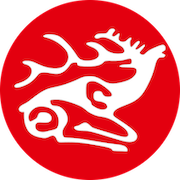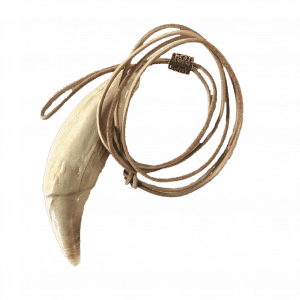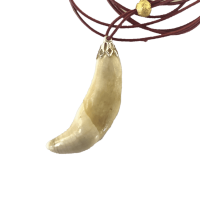The name charm comes from Aryan roots. With the ideas of kinship with the master of the forest - bear, who had divine origin and was able to patronage people, there was a recognition of his fangs and claws by a magical attribute, preserving bear energy, and the use of them as charms and signs of power.
A claw of a bear in modern times is suspended on the neck, as a charm, a sign of strength, or as a log in a car, it protects against sclase and helps to concentrate in time and not release the situation out of control.
In the old days, when a boy was born in the family, the claw of the bear was hung over the cot (from evil spirits and bad eye, from diseases and fear), and when he grew up, suspended on the neck - "to be healthy, strong and not afraid of anything."
In the peoples of Siberia and the North, bear fangs were credited with the ability to drive away evil spirits and bring their owner luck.
For Nenets, the bear 's click is protection from evil spirits, a kind of demonstration of strength, luck on the hunt. A bear click (tooth) serves as a mascot saving him from disease and danger; It also has the property of denouncing deception and craze. Among the most necessary in taiga items of knife and kresat, hunty and mansi hunters wore bear fangs on the belt, guarding the host "from the back."
There have been cases in which the mother, with the concern of the child, appealed to the pendants of the cradle to watch and protect the infant "[Ivanov C. 1977, c. 89]. Men wore claw on the belt, women on the neck. When they went to bed, the men put the belt under their heads. It was believed that in this way their sleep protected the spirit of the bear, protecting against all infighting. The bear click also protected against back pain.
The bear cult is also known in all peoples of the Caucasus. Ossetians hit the bear claw to the house so that evil forces could not enter the house. You should have hung the bear 's skull at the entrance to the house to protect the dwelling from unclean force. For the same purpose, the claw and tooth of the bear hung on the cradle of the child. Ingushi used bear claws to make amulets: they were thought to bring happiness. Karachayans were recognized bear hunters. A dangerous bear hunt gave skins, from which they sewed bear coats (ayu tone), as well as steeped the skins of the beast on the floor.
The Abkhaz removed the skin from the killed bear, which was then carefully isolated, took a piece of the bear and a right blade. The bear 's skin became a mascot of health, wealth and fertility. The blade was guessed and the future was determined. Often in the child's cradle Adyghe (Adyghes, Kabardians, Circassians) put bear claws, the strongest charm, kept it under a mattress in the child's cradle that the child grew up strong as a bear.
Charm "Bear canine"
- Product Code: H34
- Availability: In Stock
-
$51.60
Related Products
The pendant a wolf canine
The pendant a wolf canine is an original and stylish amulet. The head of a wolf is made of bronze by..
$13.76
Charm "Bear tooth"
The name charm comes from Aryan roots. With the ideas of kinship with the master of the forest - bea..
$8.60







